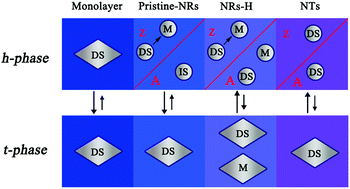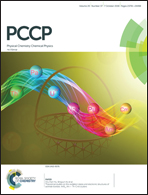The dimensional and hydrogenating effect on the electronic properties of ZnSe nanomaterials: a computational investigation†
Abstract
We performed a comprehensive first-principles study on the structural and electronic properties of ZnSe two-dimensional (2D) nanosheets and their derived one-dimensional (1D) nanoribbons (NRs) and nanotubes (NTs). Both hexagonal and tetragonal phases of ZnSe (h-ZnSe and t-ZnSe) were considered. The tetragonal phase is thermodynamically more favorable for 2D monolayers and 1D pristine ribbons, in contrast, the hexagonal phase is preferred for the edge-hydrogenated 1D NRs and NTs. The 2D h-ZnSe monolayer is a direct-bandgap semiconductor. Both the pristine zigzag nanoribbons (z-hNRs) and the corresponding edge-hydrogenated NRs gradually convert from the direct-bandgap semiconducting phase into a metallic phase as the ribbon width increases; the pristine armchair nanoribbons (a-hNRs) remain as semiconductors with indirect bandgaps with increasing ribbon width, and edge hydrogenating switches the indirect-bandgap feature to the direct-bandgap character or the metallic character with different edge passivation styles. The 1D h-ZnSe single-walled nanotubes in both armchair and zigzag forms keep the direct-bandgap semiconducting property of the 2D counterpart but with smaller band gaps. For the thermodynamically more favorable t-ZnSe monolayer, the intrinsic direct-bandgap semiconducting character is rather robust: the derived 1D nanoribbons with edges unsaturated or hydrogenated fully, and 1D single-walled nanotubes all preserve the direct-bandgap semiconducting feature. Our systemic study provides deep insights into the electronic properties of ZnSe-based nanomaterials and is helpful for experimentalists to design and fabricate ZnSe-based nanoelectronics.



 Please wait while we load your content...
Please wait while we load your content...